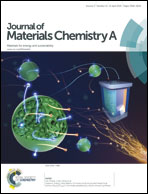Band-structure-controlled BiO(ClBr)(1−x)/2Ix solid solutions for visible-light photocatalysis†
Abstract
A group of BiO(ClBr)(1−x)/2Ix solid solutions with a homogeneous layered tetragonal matlockite structure have been explored as novel visible-light-active photocatalysts. By manipulating the composition ratio of halogen elements (I/(Cl + Br)), the band gaps of these Bi-based solid solutions can be continuously modulated in a rather wide range of 2.88 to 1.82 eV. The density functional calculations demonstrate that this continuous band gap narrowing originates from the gradual increase of valence band maximum with increasing ratio of I/(Cl + Br). The photocatalytic evaluations showed these materials possess composition-dependent photoactivities for degrading 2-propanol (IPA) to acetone and CO2 under visible light (400 < λ < 800 nm). Particularly, the highest acetone evolution rate (215.6 μmol h−1 g−1) was achieved over BiO(ClBr)0.21I0.58, which was 16.5, 11.8 and 659.3 times that of BiO(ClBr)0.5, BiOI and commercial Bi2O3, respectively. And BiO(ClBr)0.375I0.25 exhibited the best photocatalytic performance for CO2 evolution (4.8 μmol h−1 g−1, 2.3 and 23.2 times that of BiO(ClBr)0.5 and BiOI, respectively). In addition, a composition-dependent photocatalysis mechanism is proposed in detail and it involves the indirect hole-induced ˙OH oxidation or direct hole oxidation of IPA molecules in valence bands and simultaneous electron reduction of oxygen to H2O2 in conduction bands. This work not only shows that BiO(ClBr)(1−x)/2Ix photocatalysts hold great promise for practical applications but also proves that fabricating solid solutions is an effective approach to develop highly efficient visible-light photocatalysts.


 Please wait while we load your content...
Please wait while we load your content...